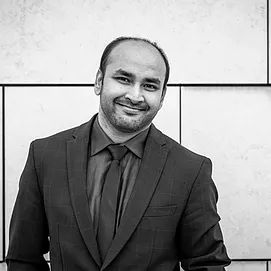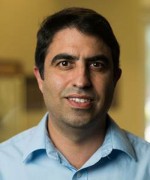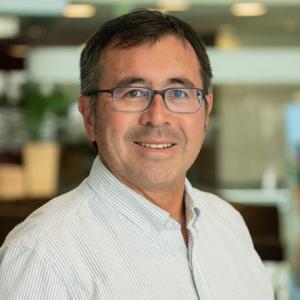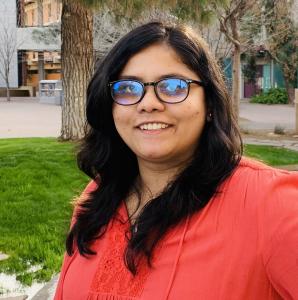This presentation will introduce a real-time traffic signal control algorithm that utilized trajectory information obtained from connected vehicles. Vehicle-to-infrastructure communications are assumed to provide the location of all connected vehicles near the signalized intersection at regular intervals in time. This information is used to identify the presence of traditional (i.e., non-connected) vehicles that are stopped at the intersection and to group all connected and identified traditional vehicles into naturally occurring platoons. Signal phasing and timing plans are then selected to optimize the sequence that these platoons are able to discharge through the intersection to minimize average delay incurred by all identified vehicles. Several heuristic methods, including intelligent tree search and multiple types of genetic algorithms, are proposed to solve the optimization problem.
Ilgin Guler is an assistant professor in the Department of Civil and Environmental Engineering at the Pennsylvania State University. Her research interests include multi-modal urban traffic operations and control, intelligent transportation systems, connected and autonomous vehicles and infrastructure management. She received dual B.S. degrees from Bogazici University, Istanbul, Turkey in Civil Engineering and Industrial Engineering and Operations Research. She received her M.S. and Ph.D. degrees from the University of California, Berkeley in Civil and Environmental Engineering. After completing her Ph.D., she served as a post-doctoral scholar in the Institute of Transport Systems and Planning at ETH Zurich, Switzerland.
Event Type: Seminar
Applications of Spatial and Data Science Approaches in Transportation Studies
Spatial data and methods are widely integrated with transportation studies. In addition, emerging data science approaches are increasingly integrated with transportation research to generate data driven solutions to complex problems. This talk explores the applications of spatial and data science approaches in urban transportation research. It provides case studies on spatial data modelling applications used to identify and understand the sustainability of the vehicular transport system. Then, it explores how data mining approaches can be integrated with transport modelling to study traffic signal optimization. Finally, it discusses the potential of innovative spatial data science methods when studying active travel in data scare contexts.
Dr. S.M. Labib is a Research Associate at Centre for Diet and Activity Research, at the University of Cambridge. His primary research focuses on developing novel quantitative spatial analytical approaches associated with geographic information science, spatial data science in studying urban built environment, and transport health impact modelling. He utilizes spatial analytics in transport-health modelling to explore the influence of the built environment and active transportation (e.g., cycling) on health outcomes.
Transportation Network Companies and Data
In this presentation, Joe Castiglione, Deputy Director for Technology, Data & Analysis for the San Francisco County Transportation Authority, will discuss the types of questions public agencies such as the SFCTA are asking about TNCs, why public agencies need good data to help decision-makers make informed choices about policies and investments, how the SFCTA acquired TNC data, and the findings from agency’s analysis of this data.
Joe Castiglione is the Deputy Directory for Technology, Data & Analysis at the San Francisco County Transportation Authority. He has been developing, refining and applying advanced transportation supply and demand models for over 20 years. He led the development of the first activity-based travel model used extensively in application in the US, and has subsequently led efforts to integrate advanced travel demand simulations with dynamic traffic models. Joe was the primary author of the Transportation Research Board’s second Strategic Highway Research Program (SHRP 2) Report S2-C46-RR-1: Activity-Based Travel Demand Models: A Primer. Recently, he has been leading the Transportation Authority’s research into the potential effects of Transportation Network Companies in San Francisco on congestion, transit ridership, and equity. Prior to joining the San Francisco County Transportation Authority, Joe worked as a consultant for transportation market research and transportation engineering firms. He has a Bachelor’s Degree from Yale with a concentration in architecture and Master of City Planning Degree from the University of California at Berkeley.
Perimeter metering control for two-region urban networks: A deep reinforcement learning approach
Various perimeter control strategies have been proposed for urban traffic networks that rely on the existence of well-defined relationships between network productivity and accumulation, known more commonly as network Macroscopic Fundamental Diagrams (MFD). Most existing perimeter control strategies require accurate modeling of traffic dynamics with full knowledge of the network’s MFD. However, such information is generally difficult to obtain and subject to error. This talk describes recent efforts to alleviate this using deep reinforcement learning for networks made up of two unique regions. The proposed methods are completely model free in that they do not require knowledge of the network’s MFD. The algorithm learns the consequences of different control actions over time and uses this information to obtain optimal control policies under different situations. Results from numerical experiments show that the proposed method: (a) can stably learn perimeter control strategies under various types of environment configurations; (b) can consistently outperform the state-of-the-art, model predictive control (MPC); (c) demonstrates sufficient transferability to a wide range of traffic conditions and dynamics in the environment; and, (d) exhibits great potential for practical implementation.
Dr. Vikash V. Gayah received his B.S. and M.S. degrees from the University of Central Florida (2005 and 2006, respectively) and his Ph.D. degree from the University of California, Berkeley (2012). Dr. Gayah’s research focuses on urban mobility, traffic operations, traffic flow theory, traffic safety and public transportation. He has authored over 50 peer-reviewed journal articles, over 50 refereed conference proceedings, and numerous research reports to sponsors. He has worked on research contracts valued at more than $5 million, sponsored by the Pennsylvania, Washington State, Montana and South Dakota Departments of Transportation, US Department of Transportation (via the Mineta National Transit Research Consortium and the Mid-Atlantic Universities Transportation Center), Federal Highway Administration, National Cooperative Highway Research Program and National Science Foundation.
Advances Toward Mobility-as-a-Service: from Traveler to Operator and Platform Perspectives
With a burgeoning market for mobility services worldwide, there is a need to understand their operations in the context of local
ecosystems, particularly as conventional transportation analysis approaches are no longer applicable. I will discuss some of the
advances we’ve made toward this topic area from a number of perspectives. From a traveler’s perspective, the conventional route
choice needs to consider network capacities that are more dynamic and dependent on flows in the system. From an operator’s
perspective, optimization algorithms should take into account the presence of coexisting systems. For agencies operating platforms
of these mobility operators, new modeling tools are needed to assess the stability of a market of one or more operators that can
provide multimodal trips to travelers.
Joseph Chow is an Assistant Professor at NYU Tandon School of Engineering’s Civil and Urban Engineering Department with
affiliations at Center for Urban Science & Progress and Rudin Center for Transportation Policy & Management. Chow is an NSF
CAREER award recipient, a former Canada Research Chair, and a founding Deputy Director of the C2SMART transportation
center at NYU. He is the 2020 Cluster Chair for Transportation Science & Logistics (TSL) Society at INFORMS, a former elected
Chair of Urban Transportation SIG, a nominated member of Freight Transportation Planning & Logistics and Network Modeling
committees and Chair of the Subcommittee on Route Choice & Spatiotemporal Behavior at the Transportation Research Board.
He has published over 60 journal articles since 2010 with over $2.5M grant funding as PI/co-PI and another $14M center funding
as a co-PI, holds Associate Editor position for two transportation journals, and received the CUTC New Faculty Award in 2018.
Dr. Chow received his PhD (’10, under Amelia Regan and Jayakrishnan) and Postdoctoral training (’10-’12, under Steve Ritchie
and Will Recker) at UCI and his MEng (’01) and BS (’00) at Cornell University.
ZEV Vehicle Adoption for a 2045 Emission Free Transportation Sector in California and High Renewable Energy Penetration
Techno-economic analysis of California energy system is being performed to find the future competition of FCEVs and BEVs for reaching an emission free electricity grid for 2045 in California. Challenges for reaching a 100% renewable electricity grid and the role of hydrogen infrastructure and FCEVs in achieving California’s 2045 ambitious goals will be discussed. An integrated energy systems model developed for transportation sector in California capable of analyzing economic values of electricity and hydrogen infrastructure in a multisector economy is shared with the audience including current results and expected outcomes.
Dr. Behdad Kiani is a Project Scientist at the Institute of Transportation Studies, University of California, Davis. He studies vehicle grid integration of Zero Emission Vehicles, hydrogen infrastructure, storage systems for utilities load management and renewable energy penetration. He has more than 20 years of experience in techno-economic optimization and integrated energy systems modelling. Prior to joining UC Davis, he was Adjunct Faculty and Research Associate at University of British Columbia and University of Victoria. Since 2017, Dr. Kiani has been acting as PI and senior researcher for several projects within Energy Futures, Sustainable Freight and 3 Revolutions Future Mobility groups, and also for Caltrans. He holds a PhD degree in Energy Systems Engineering from Tokyo University of Agriculture and Technology.
C-V2X: The Road to a 5G Automotive Future
Tomorrow’s 5G networks will address a host of verticals in three technology pillars: enhanced mobile broadband, massive Internet of Things (IoT) with many small short-range communications, and mission critical control. This talk begins with Cellular-V2X (Vehicle-to-Everything), with particular focus on the fundamentals and promise of the direct vehicle-to-vehicle, vehicle-to-infrastructure connectivity with this radio access technology. It will then segue into 5G New Radio (NR) sidelink, as 5G NR sidelink brings a special and powerful features of lower latency and enhance reliability to power 5G networks into vehicle-highway automation and enhanced reliability to enable advanced safety, increased situational awareness, energy savings, and reduced travel time.
Jim Misener is Senior Director, Product Management and the Global C-V2X Ecosystem Lead for Qualcomm. He develops and executes Qualcomm’s C-V2X deployment strategy across all global regions and works with roadside and automotive stakeholders and enabling software/hardware stack suppliers and internal teams to accomplish broad C-V2X deployment. Previously at Qualcomm, Jim led the automotive standards team and C-V2X was a major emphasis as well.
In addition to his roles at Qualcomm, Jim serves as a 5GAA board member, ITS California board member, the SAE C-V2X Technical Committee Chair and is active in TRB, which involves serving as an ITS Committee member, Vehicle-Highway Automation committee member and Automated Vehicle Symposium Enabling Technologies session organizer. Jim also serves as an Advisory Council member to the Carnegie Melon University/University of Pennsylvania/Ohio State National University Transportation Center, Mobility 21.
Jim was an early pioneer in vehicle-highway automation and vehicle safety communication at the California Partners for Advanced Transit and Highways (PATH) at UC Berkeley, starting in the mid-90s. He has served as the PATH Executive Director, Executive Advisor to Booz Allen Hamilton, and an independent consultant with clients ranging from Silicon Valley startups, the automotive industry and Federal and State government agencies. Jim holds BS and MS degrees from UCLA and USC.
The Kumbh Mela Experiment (KME): Measuring and Understanding the dynamics of mankind’s largest crowd – Experiences from Kumbh Mela 2016 in Ujjain
The large religious events in India have always thrown un-imaginable challenges of managing super dense pedestrian movements within a limited area. Kumbh Mela is a mass Hindu pilgrimage of faith in which Hindus gather to bathe in a sacred river. It is considered to be largest peaceful gathering in the world with estimated 100 million people visiting during the Kumbh Mela in 2013 in Allahabad, India and an estimated 75 million people visiting the Kumbh Mela recently held in 2016 in Ujjain, India. The safe mobility of pedestrians and crowd management during these events has always been a matter of concern for organizers and government authorities. The problem is compounded due to absence of reliable and real-time data to track movement of pedestrians and pedestrian density in designated areas. With the aim to gain more fundamental understanding of pedestrian dynamics in mass gatherings and using that knowledge to make such events safer, a major international collaborative research project called Kumbh Mela Experiment (KME) has been recently undertaken. The Kumbh Mela Experiment is an ongoing Indo-Dutch collaborative research project funded jointly by Department of Electronics and Information Technology (DeitY), Govt. of India, and the Netherlands Organization for Scientific Research (NWO), Netherlands. The Transportation Engineering (TE) Lab. at Indian Institute of Science (IISc) Bangalore is the lead partner of this project. The aim of the project is to use big data and Internet of Things (IOT) for understanding crowd dynamics in mass gatherings and develop crowd management solution particularly focusing on crowd risk. The data collection was done during the recently held Kumbh Mela in Ujjain, M.P., in 2016.
Dr. Ashish Verma is a Ph.D. from IIT Bombay and currently serving as Associate Professor of Transportation Engg. at Dept. of Civil Engg., Centre for infrastructure, Sustainable Transportation, and Urban Planning (CiSTUP), and Robert Bosch Centre for Cyber Physical Systems (RBCCPS) at Indian Institute of Science (IISc), Bangalore, India. His research interests are in; sustainable transportation planning and policy, public transport planning and management, modeling and optimization of sustainable transportation systems, non-motorized transport planning and policy etc. He has authored more than 100 research publications in the area of sustainable transportation and road safety. He has also co-authored a book on “Public Transport Planning and Management in Developing Countries”. He is Editor of ‘Transport Policy’ and Associate Editor of ‘Urban Rail Transit’. He is the Founding and Current President of Transportation Research Group of India (TRG). He is presently serving as Country Representative from India, and Steering Committee Member of World Conference on Transport Research Society (WCTRS) based in University of Leeds, UK.
Anticipating a World of Autonomous Vehicles: Implications & Opportunities for our Communities
Self-driving or “autonomous” vehicles (AVs) represent a potentially disruptive & beneficial change to the way in which we travel. This new technology will impact roadway safety & congestion, air quality & traveler choices. Benefits to individual AV owners will be on the order of $2,000 per year in the near term, thanks to crash savings, travel time reductions, fuel savings, & parking benefits. When crash savings for other roadway users are included, net social benefits are nearly $3,000 per year, rising to over $4,000 per AV over the long-term. But easier “driving” means more traffic, more emissions, and more energy use. This presentation shares various results of US surveys for fleet evolution forecasts, and agent-based simulations of shared AV fleet operations, with and without real-time ride-sharing, using both hybrid and all-electric drivetrains to help anticipate the traffic, emissions, and cost impacts of AV technologies.
Dewitt Greer Professor of Civil, Architectural & Environmental Engineering at the University of Texas at Austin, Dr. Kockelman is a registered professional engineer & holds a PhD, MS, & BS in civil engineering, a Masters of City Planning, & a minor in economics from the University of California at Berkeley. She received a Google Research Award in 2014 and was named one of the world’s Top 100 young Innovators by MIT’s Technology Review Magazine in 2002. She has received an NSF CAREER Award for her urban systems modeling work, along with the Regional Science Association International’s Hewings Award (2006), ASCE’s Laurie Price (2014), ASCE’s Bartholomew Award (2007), & ASCE’s Huber Research Prize in Transportation Engineering (2010).
Dr. Kockelman is primary & co-author of over 150 papers across a variety of subjects, all of which involve transportation-related data analysis. Her primary research interests include the statistical modeling of urban systems (including models of travel behavior, trade, & location choice), energy & climate issues (vis-à-vis transport & land use decisions), the economic impacts of transport policy, & crash occurrence & consequences. Dr. Kockelman has chaired the Transportation Research Board’s (TRB’s) Travel Survey Methods committee, & serves on TRB’s Statistical Methods, Economics, Land Development, & Traveler Behavior & Values committees. She currently serves on the editorial boards of six journals, including Transportation Research Parts B & C (for Methodological contributions & Emerging Technologies, respectively). Dr. Kockelman’s paper pre-prints & curriculum vitae can be found at http://www.caee.utexas.edu/prof/kockelman/home.html.
The role of crowdsourced Big data in detecting mobility patterns from active transportation modes in urban areas
Transportation performance management depends on quality data, yet data for bicyclists is notoriously insufficient. Most cities lack bicycle count programs altogether, and even those that have them do not generally have sufficient coverage (location, time of year, etc.) to produce reliable estimates. Without an understanding of where and when people bicycle and walk, cities, counties, and states cannot fully understand the relative risk of those activities, nor can they adequately plan for facility expansion, network completion, and maintenance. For example, bicyclist fatalities reached a 25-year high in 2016 in the USA, despite bicycle safety being an emphasis area in 36 states’ Strategic Highway Safety Plans (SHSP). While no increase in fatalities is desirable, the situation is even more dire if the increase in raw numbers is accompanied by an increased fatality rate per trip or per bicyclist – information that can only be calculated with reliable bicycle exposure estimates. Given the lack of traditional sources of bicycling ridership data (i.e., robust, consistent counting programs), crowdsourced data (eg: Strava fitness app) has emerged as a potentially key supplementary data source. However, crowdsourced data are a biased sample of ridership. While the high spatial and temporal detail and coverage of crowdsourced data make them attractive to many cities to fill gaps in traditional data sources, this should be done carefully. Some early work has indicated that integrating crowdsourced data and official counts using GIS and spatial statistics can generate ridership maps from crowdsourced data that represent all bicyclists. In this talk, we will discuss a recently created framework for generating bias adjustment factors for Strava ridership data in Tempe, AZ, to allow for use of the data to estimate bicycle ridership city-wide in a reliable way and demonstrate its applicability at a wider scale.
Avipsa Roy is a PhD candidate in the School of Geographical Sciences and Urban Planning at Arizona State University. She has a Bachelor’s degree in Computer Science from the University of Calcutta, India and a Master’s degree in Geoinformatics from the University of Muenster in Germany. She has worked in the industry for nearly 5 years as a geospatial analyst to develop algorithms that can help define spatial processes using machine learning techniques. Her PhD thesis encompasses developing quantitative methods for movement pattern analysis using GPS data. She combines computer science, spatial analytics and geographical information systems to understand spatial-temporal patterns in urban mobility.









